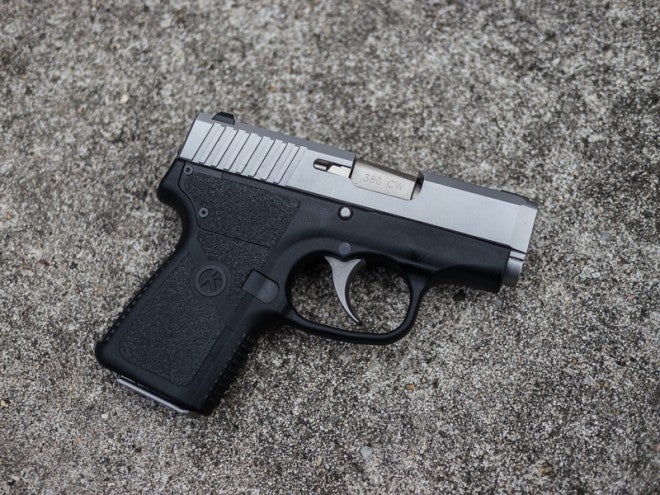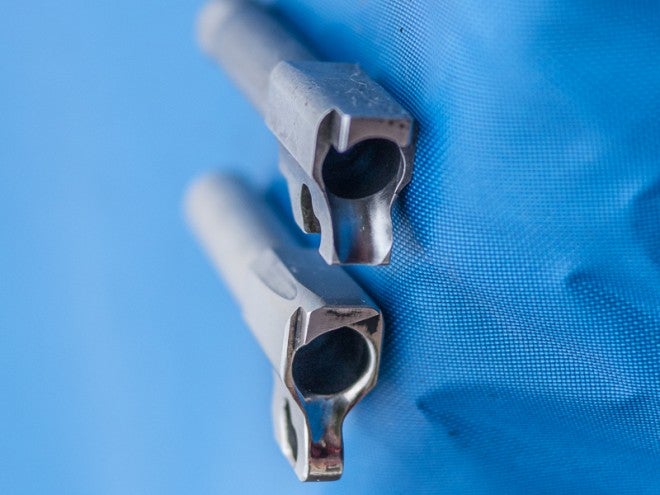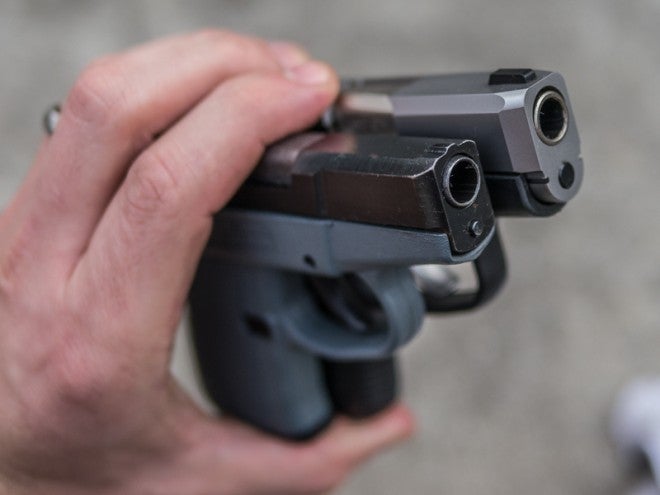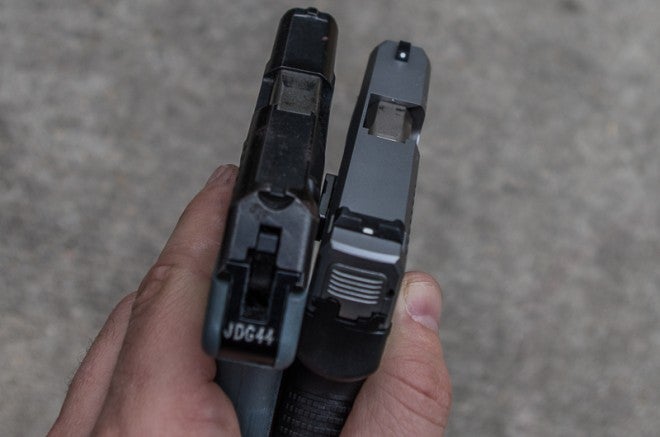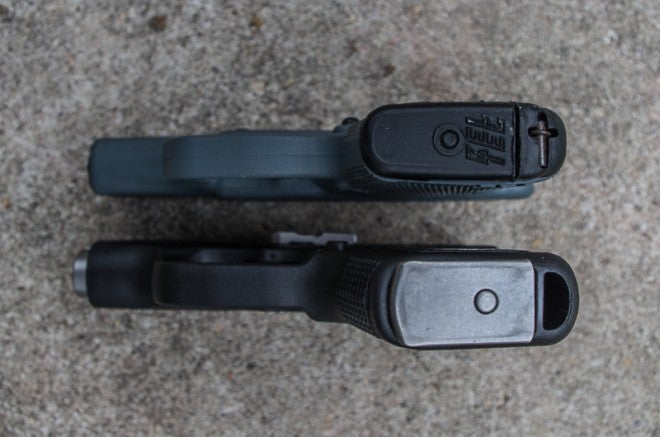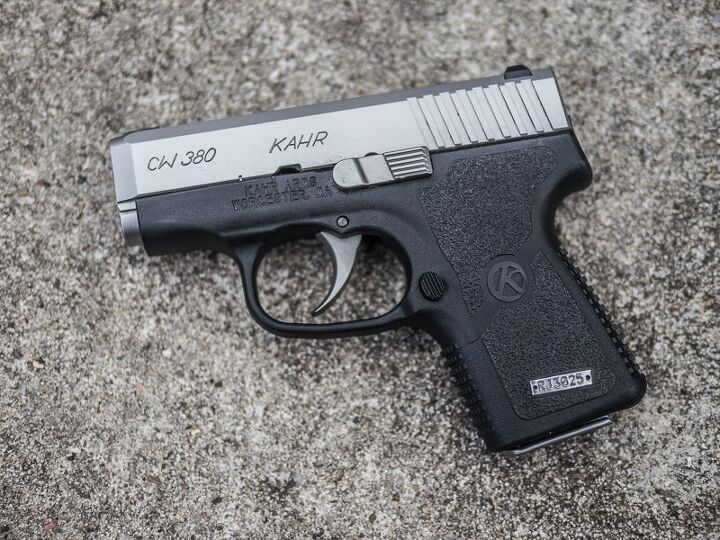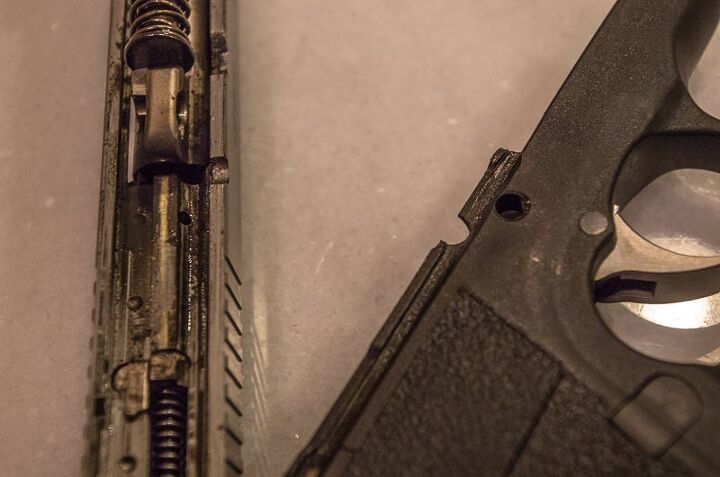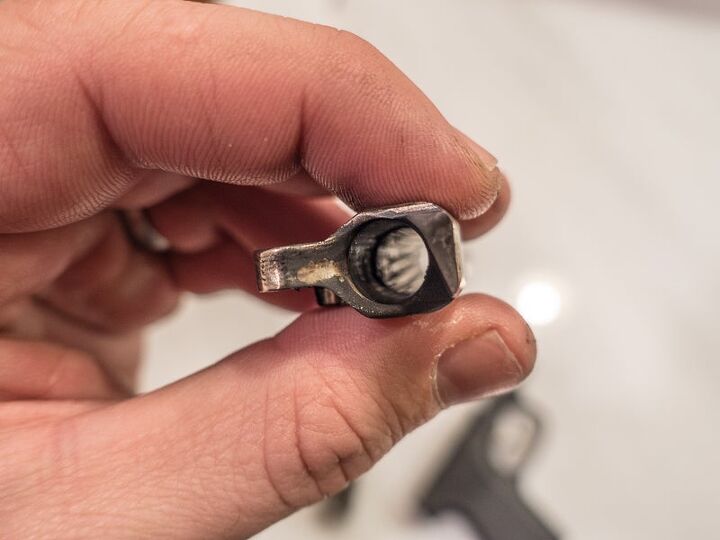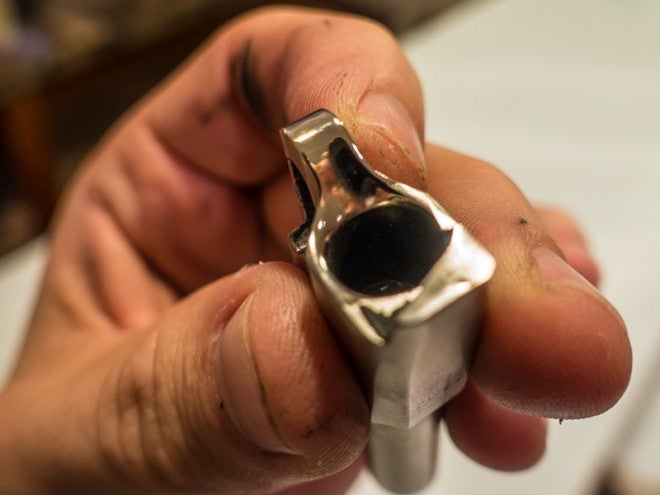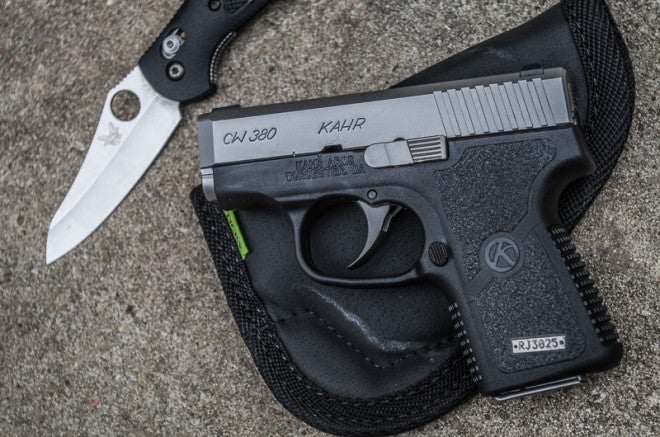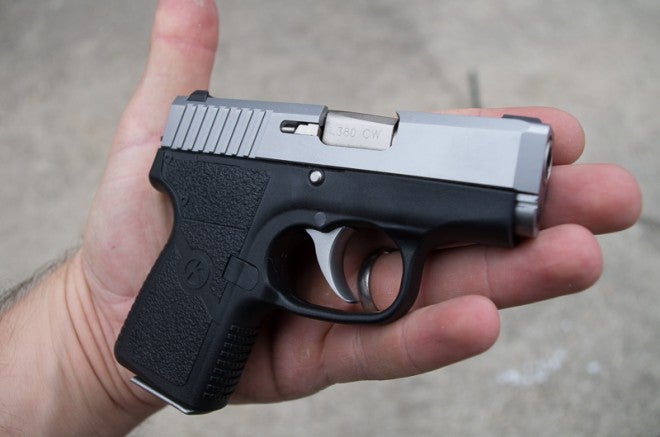A little over ten years ago, I purchased my first Kahr – the original Kahr K9. The K9 was a single stack 9mm, which was a much less common configuration ten years ago than it is today. At the time, there was no S&W Shield, Beretta Nano, Kel-Tec PF9, Springfield XD-S, Ruger LC9, or the host of other competitors that have entered the single stack 9mm market. In the late 90s and early 00s, there was Kahr, maybe the Rohrbaugh, and The Munich Trio. At the time, Kahr’s founder and CEO, Justin Moon, saw the lack of modern, ultra-compact 9mm offerings in the market and took it upon himself to design the Kahr line in 1995. Among other design innovations (including the multiple patents in each Kahr pistol), Kahr integrated an offset feed ramp which allows the trigger mechanism to fit beside the barrel lug in its pistols. Because of this, the 9mm Kahrs could be a mere nine tenths of an inch in thickness
While the Glock 26 (released a year before the K9) was only .3 inches thicker, those who have handled – or better – carried both guns know that the third of an inch is a drastic disparity, the Glock 26 feeling thick and blocky in comparison. Some readers may recall Kahr’s early “why buy a Block?” marketing which fostered and targeted this exact perception of the Glock versus the Kahr design.
That said, the K9 was, in my opinion, far from the perfect carry gun. Much like the HK P7, the K9 had a steel frame and slide, so it was 23 ounces in weight, compared to the Glock’s 21 ounces. That’s notwithstanding Glock’s greater 10+1 round capacity. Further compared to the steel-and-aluminum 15 ounce “Airweight” S&W J-frames, the Kahr was a copious half pound heavier. Moreover, Kahrs had a reputation at this time for inconsistent reliability, i.e., you either got a reliable Kahr or a Kahr that had to go back to the factory to be made reliable. At least Kahr has always had outstanding customer service. Finally, Kahr’s early steel slides would easily rust when carried against the body in the more humid climates, like my native state of Florida. The Kahr’s steel slide and frame would struggle in conditions the Tenifer-and-polymer Glock thrived in.
The introduction of the MK9 and the matte-black DLC coating alleviated some of these concerns, further shrinking the Kahr’s dimensions and weight and the DLC providing excellent rust-resistance. However, the Kahr did not really reach its full potential as a carry pistol until the introduction of the polymer-framed Kahr P9, which reduced weight to 15 ounces and maintained the same .9″ thin width. Kahr did this in 1999, and Kahr enjoyed relative exclusivity in the polymer-framed single stack 9mm market until 2007 when the Kel-Tec PF9 and Walther PPS were released. An avalanche of polymer- or aluminum-framed single stack 9mms from nearly every manufacturer followed, and the single stack 9mm is now one of the most prolific carry designs on the market.
And while Kahr was an innovator and pioneer in the single stack 9mm market, Kahr came late to the pocket .380 game. In 2003, Kel-Tec successfully modified its P-32 pistol design to accept .380 ACP, which led to the creation of the P-3AT. While .380 is, of course, less lethal than the 9mm, .380s do not need the heavier slides and recoil assemblies required by their higher-pressure 9mm counterparts. Accordingly, the P-3AT caused a stir when concealed carriers realized that they could tap into a still-lethal caliber in a pocket-sized 8 ounce package. The successful Ruger LCP .380 followed the very-similar P-3AT, and both are very popular choices for concealed weapons carriers. My wife and I both have P-3ATs ourselves.
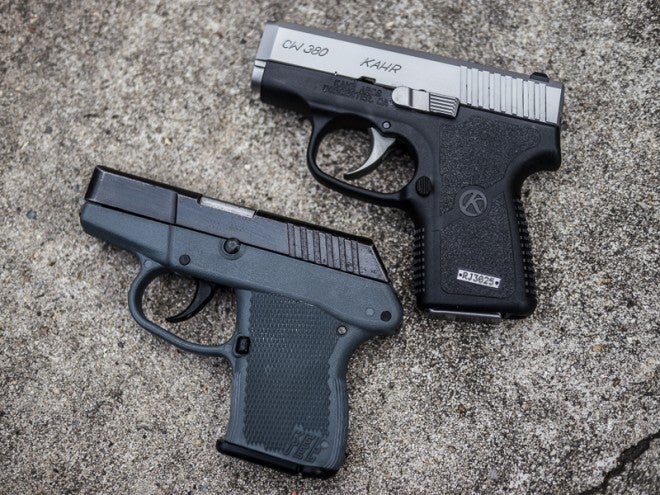
The Kahr CW380 (top) and Kel-Tec P-3AT (bottom).
Kahr revealed the P380 at the 2007 SHOT Show, and the P380 went in production in 2009. The P380 looks exactly like a scaled-down PM9, and is a mere 11 ounces in weight and .75 inches thick. And while it is my opinion that the Kahr P380 is superior in design, build, and function to the Kel-Tec P3AT, the Kahr offering significantly out-cashed both the Ruger and Kel-Tec: Street price on the Kahr P380 is about $525, while the excellent Ruger LCP can be had for about $300, and I have purchased three new in the box P3ATs for a little over $200 each. Even if the Kahr may be the superior of these three models, the Ruger and Kel-Tec .380s are still well-made and reliable, and it is difficult to justify paying double for the Kahr P380.
However, that dynamic completely changed in 2013 when Kahr added the P380 to its value line, designated by the “CW” prefix. According to Kahr: “Differences between the Kahr CW380 and Kahr P380 models include: the CW series has a conventional rifled barrel instead of the match grade polygonal barrel found on P models; the CW slide stop lever is MIM (metal-injection-molded) instead of machined; the CW series slide has fewer machining operations, and uses simple roll marking instead of engraved markings; the P380 comes with two magazines, but the CW series comes with one 6 rd steel magazine with flush baseplate.
The street price of the Kahr CW380 is about $275 (although I purchased the Kahr I reviewed for $240, brand new, and I have often seen prices hit ~$250 for the CW380). I don’t think that the upgraded barrel, slide stop, and front sight warrant double the price for a pocket .380, and I believe the P380 and CW380 would both function identically when used in the circumstances that each would commonly be used in, e.g. a close-range self-defense situation.
That said, for reasons that I will expound on below, the Kahr CW380 likely represents the best value in the pocket .380 field today. Having extensive experience with the LCP and P-3AT – Kahr’s main competition – the Kahr is significantly better than both in numerous ways, although all three are excellent choices. At a $250 price point, it’s cheaper than the ~$300 LCP, and definitely worth the $50 premium over the P-3AT.
The CW380 has a 2.58 inch barrel, an overall length of 4.96 inches and a height of 3.9 inches. It weighs 10.2 ounces without a magazine. The pistol has a black polymer frame with 4140 steel inserts molded into the frame for extra structural support. It has a machined, solid 416 matte stainless steel slide and a polymer grip.
The Kahr CW380 features a locking-breach, modified Browning-type recoil lug. The sights are a drift adjustable white bar-dot combat rear sight and pinned-in polymer front sight.
I also note that the Kahr has a functioning last round slide lock, which will hold the slide open after the magazine has been exhausted. This feature is not available on the LCP or P-3AT.
The Kahr has a capacity of 6+1. It is striker-fired, which is likely responsible for the superior and shorter trigger pull found on the Kahr but not on the hammer-fired Kel-Tec and Ruger offerings (although it would be interesting if Ruger introduced a striker-fired LCP like it did for the LC9).
Observations
I point out in advance that I purchased this Kahr for myself; TFB did not request or receive a Kahr .380 for evaluation.My first observation before hitting the range was, of course, a comparison of the new Kahr to my Kel-Tec P-3AT. When you disassemble and set the P-3AT components alongside the Kahr’s counterparts, nearly all the components – slide, slide stop, barrel, recoil assembly, trigger, and the sights, to name a few – are noticeably more robust on the Kahr, and truly make the Kahr feel like a service pistol that has been magically shrunken to fit in a pocket, while the Ruger and Kahr feel like more of a compromise – almost like a Matchbox model more than an actual pistol (the Ruger less so than the Kel-Tec). Another noteworthy difference indicative of the attention to build with the Kahr; The feed ramp on the Kahr is polished to a literal mirror-finish, while the Ruger and Kel-Tec are not. I was very impressed with the near-flawless fit and finish of the Kahr, as well as the build quality.

Comparable parts from the Kahr appear to be much more robust than those from the author’s (well-used) Kel-Tec.
Moreover, the assembly/disassembly process is much easier and less finicky on the Kahr than the P-3AT. The Kahr simply requires you to align two notches on the slide and frame and then push out the slide lock lever, while the P-3AT requires outwards pressure on the rim of the very tiny takedown pin while moving the slide rearward, which can be a trying process. Kel-Tecs can be finicky to re-assemble, and I have had at least one concealed weapons student call me to ask me how to re-assemble his P-3AT. The Kahr easily glides back into place after performing the takedown steps in the reverse order.
The manual specifies (as it always has since the 90s) that a Kahr should be run through a break in period – cleaning, lubrication, firing two hundred rounds, and then cleaning and lubricating again – before the gun can be considered “reliable.”
Having owned several Kahrs in the past decade, I was fully aware of the break-in procedure, and decided to ignore it in part this time. Presumably, this break in period is both a test of the gun’s ability to shoot through 200 rounds of your choice while also smoothing out the action and the moving parts. To accelerate this entire process, I simply shot the gun bone dry on its first day at the range – no lubrication whatsoever. I shot approximately 250 rounds of Fiocchi 95gr .380 in this first range session. After the first range visit, I cleaned and lubed the Kahr then shot 100 rounds a few weeks later.
During the first range session, the slide release was unintentionally engaged, locking the slide back after the 7th, 31st, and 37th, 63rd, and 64th rounds. It is unclear if this was operator error or if this was a malfunction. No similar issues occurred subsequent to this, and I tried to remain cognizant of the possibility that I might have actually engaged the lever, and so adjusted my grip slightly in order to prevent this from happening again. That said, I suppose this issue favors the LCP/P-3AT, which do not have prominent slide lock levers and do not hold open after the last round. One could see the virtue in that as it is easier to engage the slide lock levers on these smaller pistols versus the full-size models. On the other hand, many of my female concealed weapons students have a difficult time racking the slide on the pocket .380s, so the slide lock lever favors the Kahr in the instance where a reload is needed, should it ever come to that.
Surprisingly, this brand new pocket .380, bone dry, had no failures to feed or eject until the 121st round. From that point on, shooting became slow, as the Kahr would need a reassuring slap on the back of the slide before coughing out another round or two. The lack of lubrication, in combination with the rapid accumulation of fouling, would prevent the Kahr from returning completely into battery. I nonetheless fired approximately 250 rounds and recorded the entire process. The video is embedded below, but note that even after chopping it up a bit to remove pauses for reloading, the video is still nine minutes long and pretty boring. The first twenty magazines do go quickly before things foul up. Also, if you do watch portions where the target is correctly exposed, you can see that this gun has excellent combat accuracy. Even firing hastily, almost all rounds went into fist-size groups in the chest and head of the B-27 silhouette target used.
Unlubricated Kahr CW380 Range Test from Pelican Handgun Instruction, LLC on Vimeo.
That said, the failure to return to battery is clearly not the Kahr’s fault. A small gun with such scaled-down tolerances should obviously be lubricated before a lengthy range session. If anything, it is somewhat impressive that such a small pistol, unlubricated, managed to empty twenty magazines without a failure to feed or extract.To test that theory, a few weeks later, I cleaned and lubricated the Kahr with Tetra before I (and a few concealed weapons students) shot 100 rounds of 95gr Blazer aluminum through it, using a modified grip to avoid engaging the slide stop. All 100 rounds went through flawlessly. I am going to run another 100-200 rounds through it and update this post, but I believe that this pistol will not have any further issues. Confirming my reasoning, I read several other reviews on the Kahr before writing this one, and I did not find any other complaints of unreliability.
Ignoring any concerns one might draw from my range visits, the Kahr is definitely the best shooting pocket .380 out of the Kahr/Ruger/Kel-Tecs. The trigger comes in just shy of 5.5 pounds, and it is smooth and consistent until the striker is released. Reset is somewhat long, and there is a very small amount of takeup, but this is an excellent trigger by any measure, certainly better than competing pocket .380s and even better than most full-size pistols. Moreover, recoil is more controllable in this ergonomic pistol with its beefier recoil assembly and a couple of extra ounces afforded by the more robust components. And I would not even say that this is my personal opinion – the difference in recoil impulse from the Ruger/Kel-Tec to the Kahr is a noticeable and dramatic juxtaposition. Further still, the Ruger/KelTec pistols have black permanent/machined-on front sights that are very difficult to acquire and distinguish, while the Kahr’s white bar-dot setup offers much greater contrast and acquirability. The excellent trigger, improved recoil dampening, and the contrast sights led to more shots on target due to reduced flinch from negative association with recoil, less drastic shot anticipation (pushing) from the shorter and uniform trigger, and better sight picture and alignment from the Kahr’s bar-dot sights. Accuracy was exceptional for a pistol this size.
NEGATIVE OBSERVATIONS:
As stated, I did have issues with the slide stop. I engaged it four times (or it engaged itself) in the first range session. This eventually ceased, but the seed of doubt has been planted. Moreover, the Kahr would fail to return to battery after I fired 120 consecutive rounds through it, but this was during the break in period and, most importantly the gun was completely dry and unlubricated. Thus, this only gives me momentary pause, which slight concern is further abated by the flawless follow-up range session where the now cleaned-and-lubed Kahr managed to go through two boxes without a hitch. Finally, I think the Kahr’s slide is more difficult to manipulate with its beefier recoil spring assembly. A few female concealed weapons students who tried the Kahr absolutely could not rack the CW380 slide, but did manage to bring the Ruger LCP’s slide fully to the rear.
One other observation – this gun does have a much lighter trigger than the LCP/P-3AT and no safety. While I much prefer this to a pistol with a manual safety and/or heavy trigger, the lack of both may concern more cautious concealed weapons carriers.
CONCLUSION:
In conclusion, I think the Kahr is the best pocket .380 in its class at the time of this writing. While I have not shot any of the pocket .380s other than the Ruger LCP and Kel-Tec P-3AT, those are obviously Kahr’s main competition and probably the other two models in this price range that readers may be looking at. I do not include the Glock 42 in this category because it is very close in dimension and weight to the Kahr PM9, which I consider just outside the realm of a true front-pocket gun for most people. Price-wise, the ~$250 Kahr falls right in the middle of the range between the ~$200 Kel-Tec and the ~$300 Ruger LCP. The Kahr CW380, as reviewed, is also half the price of the Kahr P380, which has a polygonal rifled barrel, machined slide stop, an extra magazine, and a dovetailed front sight, which the CW380 lacks. For a pocket .380, these improvements are not nearly worth the expense.
And while the build of the Kahr is excellent, with heavier-duty components, flawless machining, and attention to detail on minor details like surface and ramp polishing, a metal (versus plastic) trigger, and a simpler assembly/disassembly process, what really sets the Kahr apart are the sights and trigger, which are both the best-in-class. The trigger is better than your full-sized Glock’s trigger, smooth and without a noticeable stacking/breaking point, which leads to reduced shot anticipation. Further, the recoil handling far outclasses the Ruger or Kel-Tec offerings, and this was reinforced by the concealed weapons course students who shot the Kahr on the second range trip, all of whom said this same thing.
Despite some issues with the slide stop (which issues have not resurfaced for the ~300 subsequent rounds), this proved to be a reliable pistol after broken in and cleaned/lubed. I may have to put a few more boxes down the tube before placing full faith in this gun, but when I do, the Kahr CW380 will be my top choice for an ultra-compact .380 ACP pistol. This is an excellent pistol.
We are committed to finding, researching, and recommending the best products. We earn commissions from purchases you make using the retail links in our product reviews. Learn more about how this works.
 Your Privacy Choices
Your Privacy Choices
